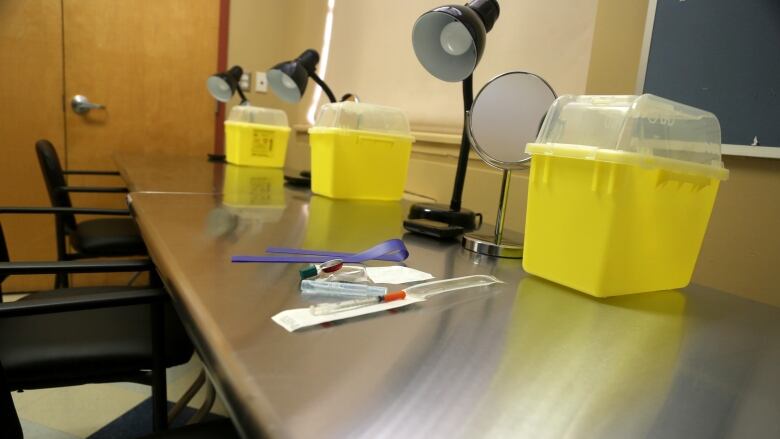Take a look inside Hamilton's first overdose prevention site
People over the age of 16 who aren't intoxicated or having a medical emergency can use the site

Behind a quiet side door surrounded by graffiti at the Hamilton Urban Core Community Health Centre is the first city's overdose prevention site (OPS), where peoplewill be able to inject, snort and take drugs orally starting at 8 p.m.
Visitors will find a one-room setup witha desk lamp,sharps disposal box and a mirror so people who inject into drugs into their jugular can see what they're doing set out on a metal table in front of three stations.
The officialopening of small, simple spacemarks a major step in the city's move towardharm reductionas a way of treating addiction, by providing a physical location where addictscan use drugs under supervision and access clean needles and other safe injection tools.
The site, which will berun by the Shelter Health Network in partnership with Hamilton Urban Core CHC, comes after it was approved by the province and given enough funding for six months back in May.
A team of advocates has been fighting for months to set up a site to respond to the city's growing opioid crisis, whichDr. Jill Wiwcharuk said includes 87 people who died of opioidpoisoning in 2017, compared to 52 the year before.

She added the site is already anticipating a lot of users so much so that they've included timers at each of the site's three stations to encourage people to get up after about 20 minutes.
The floor behind the chairs will have resuscitation mats, incase anyone overdoses. Equipmentsuch as needles, alcohol swabs and, of course, Naloxone, are contained in a cabinet nearby.

On the other side of thesmall partition that separates the one-room setup,is the "chill out room" which has three comfy black chairs where people can be monitored after using drugs before heading home.
The site will be staffed by at least three people at all times, one of whom will be a doctor or nurse.
Dr. Robin Lennox from the Shelter Health Network walks us through how the OPS will work. #HamOnt pic.twitter.com/b4fMTy1tfL
—@DanTaekemaWiwcharuk said Hamilton'sOPSwill be "special" because most of the 30-odd staff members who have signed up have already been working with the drugs users in the community.
"What we have tried to create here is a space that when people come in they're going to see people they already know in the community," explained Wiwcharuk. "They're going to recognize our faces and they're going to trust us already."
'We won't be checking IDs'
The doctor added anyone age 17or older can use the site andstaff won't be checking IDs.
"We're not looking for OHIP cards, we're not looking for driver's licenses. We wouldn'thave much business if we did that."
Here are the eligibility requirements to use theOPS:
- Users must be willing to sign the Consent Form for emergency treatment (first time they come only)
- Users must be willing to adhere to the OPS Code of Conduct
- Users must not be exhibiting overly aggressive behaviour
- Users must not be overly intoxicated
- Users must not have a medical condition that needs immediate attention
Those requirements don't bar pregnant women from using the site, according to Hamilton Urban Core executive director Denise Brooks.
"The risk has to be that you're going to use anyway, so if you're going to use then at least be safe and stay alive," she said.

The site is just two blocks from Hamilton police headquarters, but Wiwcharukand Brooks don't anticipate any problems.
Staff have been meeting with police regularly to discuss the site and Brooks said Urban Core already has a great relationship with the service some officers already often stop by to say hi and drink coffee.
But that doesn't mean staff haven't considered what impact police could have on the site.
Wiwcharuksaid any 911 calls about overdoses will come with a request thatpolice not attend, and any time an emergency call is made, people using the site will be warned police could be arriving, in case they want to leave.
"Certainly our service users are not going to be overly happy if there's a large police presence and that could compromise the whole operation."

Urban Core already has security protocols and training in place, said Brooks, so she's not concerned about the safety or concerns from some, including police chief Eric Girt, that the site could attract drug dealers.
"The chief now isn't as familiar [with Urban Core]," she said. "So part of it is educating him too."
Wiwcharuksaid she believes thebiggest advocates for safety and security at the site will actually be the users themselves.
"They are going to take ownership of this place. They are going to be helping police themselves because they are protecting this."

The site will be open every Monday, Wednesday, Friday, Saturday and Sunday from 6 p.m. to 11 p.m. and on Tuesdays and Thursdays from 8 p.m. to 11 p.m.
- MORE HAMILTON NEWS | Fear of Ontario's deficit drives recent university grad to campaign for the PC party
- MORE HAMILTON NEWS |Steel city mayors ask U.S. counterparts for help fighting steel tariffs












_(720p).jpg)


 OFFICIAL HD MUSIC VIDEO.jpg)
.jpg)



























































































